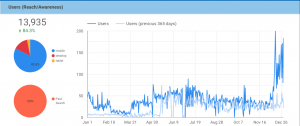
No matter how enticing your marketing, it is very unlikely that every visitor to your website is the best lead for your business. While a higher website conversion rate is a great target, the ultimate goal is to get more revenue.
A high-quality website can help you qualify and convert potential customers and weed out those web visitors’ whose needs are not in line with your services or products. If your business is inundated with poor quality leads, then your website isn’t doing its job.
Get Qualified Leads from Your Website
1. Clearly Articulate Your Differentiator
When a web visitor lands on your website, they typically have two questions: what is this business? And, can they help me with my problem?
Since the majority of web visitors will enter the site through your home page, the top section of the home page should have a strong web-based value proposition, which states who you are, what you do, and what differentiates your business.
By clearly stating what sets your business apart, you are not only differentiating your offerings from competitors but you are also weeding out any visitors who aren’t looking for your specific services.
2. Focus on Who You Serve
Another way to pre-qualify web visitors is to clearly state who your business serves. It can be tempting to generalize the description of your services in the hopes of keeping the doors open to as many clients as possible. However, you’d be doing yourself a disservice. The more clearly you communicate who you serve, the more qualified leads you will generate.
You can do this in a subtle way or with clear statements and pages. The subtle option is to display some of your client logos on the site, and allow potential customers to draw conclusions based on their similarity to those clients.
If your business works only with clients in certain industries, then an overt approach is to create an Industries website page where you describe your business’ expertise in each of those areas. This option has a bonus effect: showcasing your clients and even some testimonials is also a great way to establish trust and credibility with web visitors.
3. Provide Pricing or Price Ranges
Listing pricing on your website is one of the best ways to qualify visitors. For some products or services, you may display a pricing table with tiers and a breakdown of what’s included in each one.
If you do place pricing on your site, it’s important to make sure the information is always accurate and that it clearly describes the parameters for payment and what’s included. In this way, you’re creating a level of both transparency and professionalism.
However, for some B2B website designs or complex purchases, you may not be able to publicly publish pricing on the website. In those scenarios, you can indicate some aspects of your pricing by using adjectives like “premier” or “affordable” in the content.
4. Offer FAQs or Live Chat
A frequently asked question page can be a great resource for potential customers. Most FAQ web pages use a tool called an accordion where the answers to each question are hidden until a web visitor clicks to view that particular question.
With this setup, your business can share a lot of information in a very intuitive and clean format. An FAQ page helps to address common objectives and questions that come up during the early sales process.
Adding live chat to your website is another great option for qualifying leads while adding a little bit of a personal touch. Web visitors can start a chat and get a few questions answered by your team. It can be a great way to help the potential client determine if they are in the right place.
5. Use Contact Forms as a Gatekeeper
Contact forms are typically the final step in converting a web visitor, but these forms can also be a final gatekeeper on your site. On the one hand, it’s best to request only the most important information in the website form, as longer forms can deter a web visitor.
However, you can also start to qualify leads by requesting certain information in a form field. You can also create different landing pages or forms for each service or type of request. For instance, most websites have a contact page with a contact form. This form is typically a catch-all and it’s used by a variety of web visitors including existing clients, prospective employees, partners, etc.
If your site is focused on lead generation, set up a specific call to action and form for new prospects. You can then tailor that form by asking them what type of service they are interested in or by including an upload area to upload an RFP document.
Don’t Be Afraid to Niche Down
As a business owner, you may be hesitant to define a specific niche in fear that you’ll be side-stepping potential revenue. The opposite is actually true: by specifying your niche, you’ll weed out the qualified prospects from the passers-by.
If your website isn’t clearly articulating your differentiator, it may be time to redesign the website and make sure it is catering to the needs of those web visitors who really match your offerings.
Digital & Social Articles on Business 2 Community
(29)






